Marc Weidenbaum's Blog, page 236
May 16, 2020
Buddha Machine Variations No. 32 (Microloop Trial)
This is a Saturday evening trial run at selecting tiny bits of a single loop from a Buddha Machine and having them pulse against each other. Eventually the main source line is eliminated so that only these microloops remain. Toward the end, two of the microloops are further affected by delays that warble by changing ever so slightly within a narrow range at a rapid pace. There’s not much more to it than that. The source audio is the third generation of Buddha Machine, called Chan Fang, which came out a decade ago, back in 2010. The instrument heard is the qin, a Chinese zither.
There are five channels into the mixer. The purple one, channel five, is the unadulterated source audio. Channels one through four each get their own individual micoloop in real time, one at a time. Channels three and four are the ones eventually set to warble (channel four starting at 3:24, channel three at 4:52). The loops and delays occur in the ER-301 (the large synthesizer module in the lower left, running the Pedal Looper and Delay units). The warble is a result of a pair of waves that come from a combination of the Batumi (the one with four vertical levers directly above the ER-301) and the S.P.O. (the one with four black knobs, two to the right of the Batumi). I’m going to explore this approach further, likely combining microloops from various loops of the Chan Fang.
For further patch-documentation purposes, here is a straight-on shot of the synthesizer:
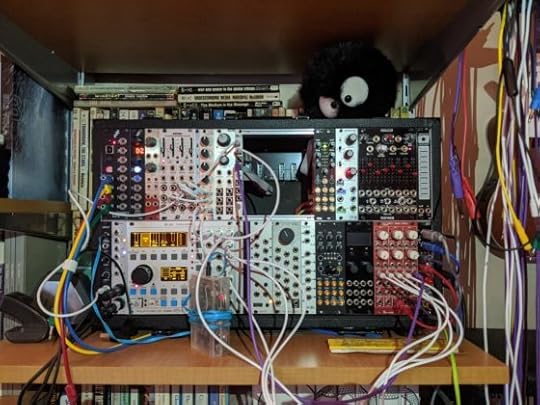
Video originally posted at youtube.com/disquiet. There’s also a video playlist of the Buddha Machine Variations.
This Week in Sound: Loud Birds and Quiet Times
These sound-studies highlights of the week are lightly adapted from the May 12, 2020, issue of the free Disquiet.com weekly email newsletter This Week in Sound (tinyletter.com/disquiet).
As always, if you find sonic news of interest, please share it with me, and (except with the most widespread of news items) I’ll credit you should I mention it here.
▰ ▰ ▰ ▰ ▰ ▰ ▰ ▰ ▰ ▰ ▰ ▰ ▰ ▰ ▰
THIS WEEK IN SOUND
▰ “Although our perception might be that they’re singing louder, it’s actually likely in places that are typically noisy that they’re singing more quietly than normal.” Sue Anne Zollinger tells us birds aren’t louder than usual, clarifying what a lot of people are experiencing during widespread shelter-in-place. Zollinger is an ornithologist at Manchester Metropolitan University.
https://www.kpbs.org/news/2020/may/06/do-those-birds-sound-louder-to-you-an/
▰ A new educational app, Diya, “monitors the child as they read, using Google’s speech recognition technology to spot mistakes and places where they are having trouble.”
https://voicebot.ai/2020/05/08/google-launches-new-voice-assistant-and-app-to-teach-kids-to-read/
▰ “I always thought field recording was just an audio snapshot, really. Now, taking the audio snapshot and adapting it to our present moment – who knew our times [would] so drastically [change] in a matter of two weeks. And my god, all of these field recordings that we’ve all been doing for the past 20-30 years, especially as the hand-held recorders got more and more accessible for the general public – I used to think of it all as, What are we going to do with all this stuff? It’s just trash, everybody’s just recording field recordings. I’d always roll my eyes. Now I’m like, You’re such an idiot. Thank god everybody was recording our world because it’s gone.” Many thanks to Jason Richardson for having brought this observation from the awesome Maria Chavez to my attention.
https://bassling.blogspot.com/2020/05/grief-for-changed-world.html
▰ A Florida man is suing another for using a “sonic weapon” again him and his family: “The petition describes the noise as ‘continual pinging’ and argues the noise is known to cause hearing loss and tinnitus.”
https://floridapolitics.com/archives/331415-dont-social-distance-here-seminole-neighbor-allegedly-blasts-high-pitched-pinging-sound-at-neighbors
▰ “A federal judge has refused to dismiss a class-action complaint alleging Google’s voice-activated Assistant violates users’ privacy,” writes Wendy Davis at MediaPost of a ruling by U.S. District Court Judge Beth Labson Freeman in San Jose. A Reuters piece on the same topic can be read to cast the results differently, with the title “Google beats most claims in voice assistant privacy lawsuit.” The Reuters piece does note the plaintiffs have “the opportunity to amend the complaint.” Davis arguably makes the judgment more clear: “Freeman dismissed several other claims in the complaint, but without prejudice — meaning that the users can attempt to reformulate them.”
https://www.mediapost.com/publications/article/351152/google-cant-shake-privacy-lawsuit-over-voice-acti.html
https://www.reuters.com/article/dataprivacy-google/google-beats-most-claims-in-voice-assistant-privacy-lawsuit-idUSL1N2CP2R1
▰ “Banks and the companies that provide their voice biometrics make bold claims for the ability to distinguish individuals’ voices. Hundreds of speech characteristics are analysed, from accent and speed to physical characteristics of vocal chords.” That’s Ed Jefferson describing the rise of voice as a form of password. The idea of names having magic power is a common trope. I happen to be reading the first book in Jim Butcher’s series The Dresden Files, Storm Front, and figured I’d share this bit from it for comparison: “There are two parts of magic you have to understand to catch a faery. One of them is the concept of true names. Everything in the whole world has its own name. Names are unique sounds and cadences of words that are attached to one specific individual sort of like a kind of theme music. If you know something’s name, you can associate yourself with it in a magical sense, almost in the same way a wizard can reach out and touch someone if he possesses a lock of their hair, or fingernail clippings, or blood. If you know something’s name, you can create a magical link to it, just as you can call someone up and talk to them if you know their phone number. Just knowing the name isn’t good enough, though: You have to know exactly how to say it. Ask two John Franklin Smiths to say their names for you, and you’ll get subtle differences in tone and pronunciation, each one unique to its owner. Wizards tend to collect names of creatures, spirits, and people like some kind of huge Rolodex. You never know when it will come in handy.”
https://www.raconteur.net/technology/voice-biometrics
▰ “A Supreme Court argument was briefly interrupted Wednesday by the sound of what appeared to be a toilet flushing.”
https://abc7news.com/politics/sound-of-apparent-toilet-flush-interrupts-supreme-court/6157556/
▰ ▰ ▰ ▰ ▰ ▰ ▰ ▰ ▰ ▰ ▰ ▰ ▰ ▰ ▰
GRACE NOTES
▰ A welcome green shoot of civilization: just learned that a local shop on the other side of the park will hand-deliver sheet music. Having sheet music delivered by hand from a locally owned business while the city is under shelter-in-place guidelines does make me feel like I am living in a Brian Wood comic.
▰ Today’s definition of optimism: Stumbling on a generative modular-synth ambient video on YouTube and observing as muscle memory immediately sets it to loop, even though it’s three hours long.
▰ First Tony Allen, then Florian Schneider, then Little Richard. The Earth is losing its rhythms. It’s off its axis. (Side note: It feels odd how few obituaries for Little Richard mention the Magic School Bus theme.)
▰ RIP, Richard Sala. His was one of the first comics I edited for Pulse!, the Tower Records music magazine, back in the early 1990s. I was an enormous admirer, and I learned a lot from him.
▰ Body: sheltering-in-place. Mind: woodshedding.
▰ ▰ ▰ ▰ ▰ ▰ ▰ ▰ ▰ ▰ ▰ ▰ ▰ ▰ ▰
Subscribe to This Week in Sound at (tinyletter.com/disquiet).
May 15, 2020
Buddha Machine Variations No. 31 (Narrowed Divide)
One thing that occurred to me as I’ve reached the end of a full month of daily Buddha Machine Variations is that I am accessing a familiarity with the source recordings that has only one direct comparison for me, which is the year I spent daily listening to and writing about one of my favorite albums of all time, Selected Ambient Works Volume II by Aphex Twin. As I searched for a Buddha Machine loop for today’s exercise, I realized that as I clicked through the options, I knew what would be next: Not only were the individual loops familiar as a friend’s voice on the phone, so too were the loops’ relative proximity to each other. And as I listened to the audio as it was being processed, I adjusted the various options in accordance with the specific loop’s qualities. And when I thought back on how this patch came together, I realized the decisions about what kind of processing to engage in were rooted in the source material. That point is distinct from where I began 31 days ago, when the audio was more of a discreet object, and the processing a discreet application. The divide between them has narrowed.
In any case, this piece has four subsidiary parts. I’ll describe them in brief, one channel of the mixer at a time, from left to right. Channel one is the straight audio out of the Buddha Machine, but with a slight variation on the delay, lending it a warble quality (delay via the ER-301). Channel two is the same unadulterated audio, its volume increasing and decreasing thanks to a slow, shallow wave (courtesy of the o_C module, running the Hemisphere firmware). Channel three is a narrow band of the FXDf-derived audio (from the source loop), put through a slight, static delay (in the ER-301). And channel four is another narrow band of the FXDf-derived audio, set on a little loop that is constantly overwriting itself. The loop is a little over two seconds long, and the trigger for the recording is going at a different pace, so over time the audio that is heard in this loop changes. (The loop kicks in at 1:05, when I connect a cable from the Batumi to the ER-301.) Beyond that, it’s all just me manipulating the various channels, based on my understanding and appreciation of the source loop, its melodic qualities, and the stages that comprise its structure.
There was no entry yesterday because after I recorded it last night I realized there was an issue with the audio, so I waited until today to re-record it. In the process I changed the patch, adding some elements.
For further patch-documentation purposes, here are two shots of the synthesizer:
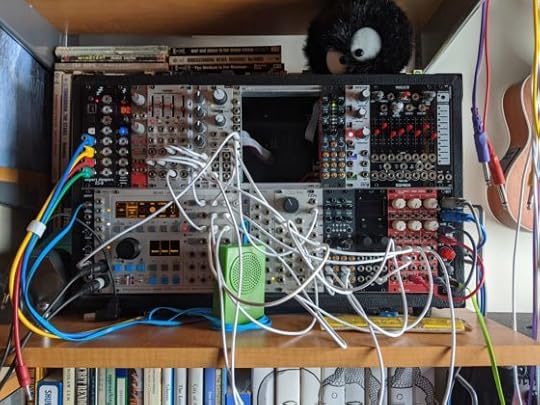
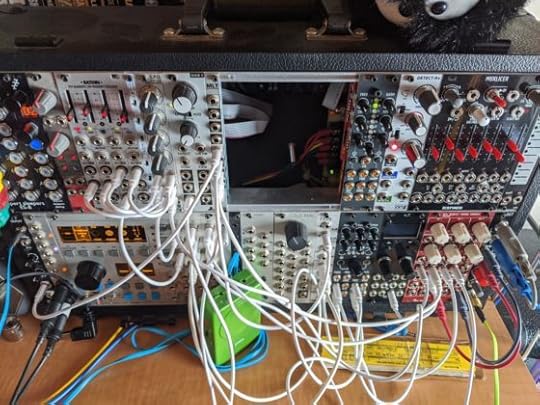
And the settings on the Ornament and Crime module, the screen of which had gone dark while the video was being shot:
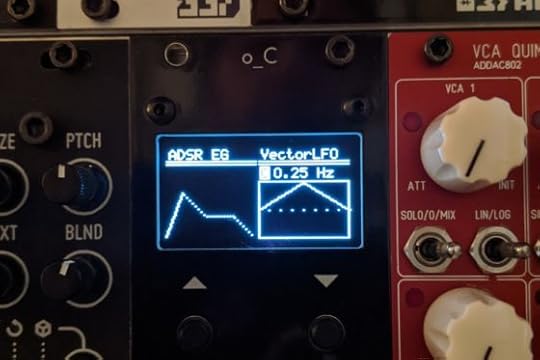
Video originally posted at youtube.com/disquiet. There’s also a video playlist of the Buddha Machine Variations.
May 14, 2020
Buddha Machine PSA
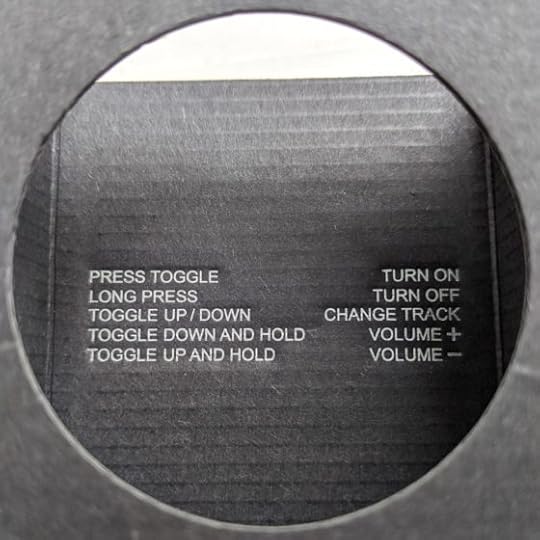
In the process of working on Buddha Machine Variations the past few weeks, I’ve been re-informing myself about these wonderful devices created by FM3. Much of this education is the algorithmic equivalent of second-hand smoke. If you post a lot of YouTube videos of Buddha Machines, then YouTube recommends videos of Buddha Machines. One consistent subject of comments pops up: complaints about the controller for the Philip Glass edition, which was produced to coincide with the composer’s 80th birthday. Among the complaints: that the device’s volume can’t be changed. This isn’t true. The instructions on how to raise and lower the volume are printed on the inside of the paper case that holds the device. This is my first, and likely last, Public Service Announcement where the Buddha Machines are concerned.
Oh, and there’s no Buddha Machine Variations video today, because I had some sort of technical error when recording. The patch is still in place, so I’ll revisit it when I get a break tomorrow and post it to youtube.com/disquiet.
Disquiet Junto Project 0437: Echo Relocation

Each Thursday in the Disquiet Junto group, a new compositional challenge is set before the group’s members, who then have just over four days to upload a track in response to the assignment. Membership in the Junto is open: just join and participate. (A SoundCloud account is helpful but not required.) There’s no pressure to do every project. It’s weekly so that you know it’s there, every Thursday through Monday, when you have the time.
Deadline: This project’s deadline is Monday, May 18, 2020, at 11:59pm (that is, just before midnight) wherever you are. It was posted on Thursday, May 14, 2020.
These are the instructions that went out to the group’s email list (at tinyletter.com/disquiet-junto):
Disquiet Junto Project 0437: Echo Relocation
The Assignment: Record someone else’s field recording of their environment playing within your own.
This project is a collaboration with the artist and experimental philosopher Jonathon Keats.
Step 1: Select one or more of the field recordings submitted to the Junto last week. There is a playlist of nearly 50 at
https://soundcloud.com/disquiet/sets/disquiet-junto-project-0436
And a couple more sprinkled through the discussion at
https://llllllll.co/t/disquiet-junto-project-0436-planetary-headspace/
Step 2: Play the track(s) in your own environment, indoors or outside, situating other people’s acoustic environments in your living space.
Step 3: Record the confluence of near and distant sounds.
Step 4: Share your new field recording for others to play and record in their own living environments.
Seven More Important Steps When Your Track Is Done:
Step 1: Include “disquiet0437” (no spaces or quotation marks) in the name of your tracks.
Step 2: If your audio-hosting platform allows for tags, be sure to also include the project tag “disquiet0437” (no spaces or quotation marks). If you’re posting on SoundCloud in particular, this is essential to subsequent location of tracks for the creation of a project playlist.
Step 3: Upload your tracks. It is helpful but not essential that you use SoundCloud to host your tracks.
Step 4: Post your tracks in the following discussion thread at llllllll.co:
https://llllllll.co/t/disquiet-junto-project-0437-echo-relocation/
Step 5: Annotate your tracks with a brief explanation of your approach and process.
Step 6: If posting on social media, please consider using the hashtag #disquietjunto so fellow participants are more likely to locate your communication.
Step 7: Then listen to and comment on tracks uploaded by your fellow Disquiet Junto participants.
Additional Details:
Deadline: This project’s deadline is Monday, May 18, 2020, at 11:59pm (that is, just before midnight) wherever you are. It was posted on Thursday, May 14, 2020.
Length: The length is up to you. Let nature take its course.
Title/Tag: When posting your tracks, please include “disquiet0437” in the title of the tracks, and where applicable (on SoundCloud, for example) as a tag.
Upload: When participating in this project, be sure to include a description of your process in planning, composing, and recording it. This description is an essential element of the communicative process inherent in the Disquiet Junto. Photos, video, and lists of equipment are always appreciated.
Download: Given the nature of this particular project sequence, it is best to set your track as downloadable and allowing for attributed remixing (i.e., a Creative Commons license permitting non-commercial sharing with attribution, allowing for derivatives).
For context, when posting the track online, please be sure to include this following information:
More on this 437th weekly Disquiet Junto project, Disquiet Junto Project 0437: Echo Relocation — The Assignment: Record someone else’s field recording of their environment playing within your own — at:
This project is a collaboration with the artist and experimental philosopher Jonathon Keats.
More on the Disquiet Junto at:
Subscribe to project announcements here:
http://tinyletter.com/disquiet-junto/
Project discussion takes place on llllllll.co:
https://llllllll.co/t/disquiet-junto-project-0437-echo-relocation/
There’s also a Disquiet Junto Slack. Send your email address to twitter.com/disquiet for Slack inclusion.
Loop Bingo
May 13, 2020
Buddha Machine Variations No. 30 (Organ Specter)
One Buddha Machine, the Philip Glass edition, playing the organ loop, three processed channels of which go into the mixer. When the piece begins, it’s just the signal going through the granular synthesizer (channel two). Then comes the main line (channel one), which is the output of the Muxlicer. There are eight randomly selected outputs from the Muxlicer: six bands of the filter bank, and two of the granular synth, all set at different volume levels. They’re being selected at random, and the clock that sets the pace of the Muxlicer changes regularly. The basic pulse is a square wave from the Dixie II. There’s a hybrid wave from the Batumi, via the SPO, that occasionally makes the Dixie II pick up the pace, as a result of two different combined waves. The third channel of the mixer is a copy of the audio in the second channel, that of the granular synth processing the inbound signal, except it’s going through the ER-301 and being delayed. The intention was to overlap the granular phrase so that there are fewer gaps in the sound. In addition, the value of the delay on the third channel of the mixer is rapidly shifting tiny increments, so its relative position to the second channel is always changing. That about covers it.
For further patch-documentation purposes, here’s a straight-on shot of the synthesizer:
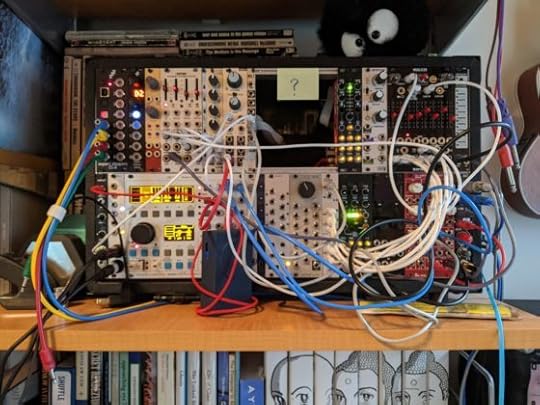
Video originally posted at youtube.com/disquiet. There’s also a video playlist of the Buddha Machine Variations.
New Void in Town
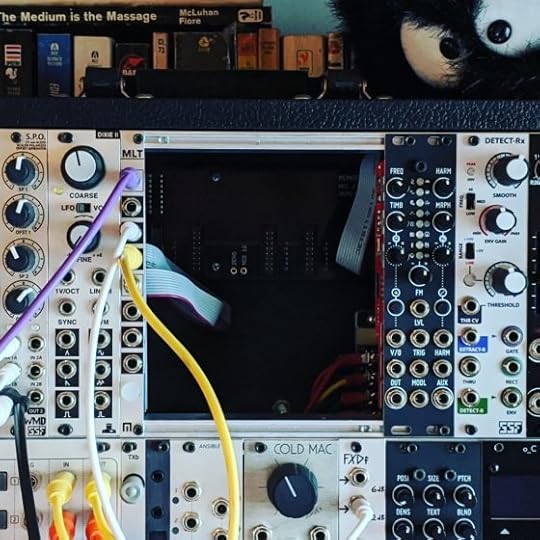
There’s a new void in town. Need to sort out if and with what to fill it. Less on the sound processing side, more on the CV tools side.
New Category: Studio Journal
There’s a new category on Disquiet.com, in addition to Field Notes, and Downstream, and so forth. It’s Studio Journal, and it’s a place to store away notes (and video, and audio) as I explore music-making. Previously there was a tag called studio journal, but in light of the increased activity I’ve been pursuing with my synthesizer, I figured it’s time to give this material its own section on the website.
Serial Sound
I was taking long walks at night until I began to find them unnerving. I’ll start again at some point. The last time I took one coincided with the first episode of season two of Ninth Step Station (created by Malka Older, serialized by Serial Box). That must have been five weeks ago tonight. I stepped out onto the sidewalk after dark and thought, “Yeah, this is what I need. To visit future-Tokyo – you know, even if it’s one plagued by violence and broken into pieces following a devastating war.” I wondered how the sound design would contrast with my walk.
Within a few minutes, I heard something drop behind me. Fully knowing I was listening to a show (it opens in a bar), I looked around. Then, even though all the more aware of the overlap of everyday sound (I was wearing headphones but not noise-canceling ones) and the serial’s sound, I became conscious of a fight in the distance. I got anxious immediately. And again, it was merely sound design experienced on an otherwise empty street. Actually, not “merely.” The opposite of merely. Viscerally.
As the show proceeded, and my experience of the episodes moved from outdoors to indoors, I came to focus on other elements. Indoors, things like bar fights don’t alert me. Indoors, it’s the ambient electronic noises of devices that make me look up, check my phone, tap my earbud.
Note: This is a slight variation (changed to “tonight” from “tomorrow”) of something I published last night in the This Week in Sound email newsletter, and adapted from something looser I’d posted to Twitter awhile back. Twitter being my public notebook.




